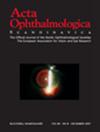Defocus incorporated multiple segments lenses and 0.025% atropine for myopia control in European children: 12-month results of a randomized controlled trial
Abstract
Purpose: Defocus Incorporated Multiple Segments (DIMS) lenses and atropine have proven standalone efficacy in controlling myopia progression in children. However, there is a scarcity of evidence of their efficacy when used in combination. This randomized controlled trial (RCT) aims to evaluate the efficacy of combination treatment using 0.025% atropine and DIMS spectacle lenses compared to 0.025% atropine and single vision (SV) lenses in slowing myopia progression in European myopic children.
Methods: RCT conducted on children aged 4-16 years with myopia between -1.00 and -6.00D and astigmatism ≤2.00D. Children were randomly assigned to the 0.025% atropine and SV lenses treatment group (group A) or 0.025% atropine and DIMS lenses treatment group (group B). Cycloplegic spherical equivalent refraction (SER) and axial length (AL) were measured at baseline, 6 and 12 months. Statistical analyses (Mann-Whitney U-test or Chi-squared test) were performed to test for significance between the two groups.
Results: 79 patients completed the 12 month-follow-up: n = 38 (48.1%) in group A (47.4% female), mean age 9.00 ± 2.74 years; n = 41 (51. 9%) in group B (46.3% female), mean age 9.68 ± 2.65 years. There was no significant association between group and sex (p = 0.93) or age difference between the groups (p = 0.26). At 12 months, mean AL ± SD change was 0.16 ± 0.13mm in group A and 0.09 ± 0.16mm in group B, mean difference 0.07 ± 0.02 mm (95%CI 0.03-0.12, p < 0.001). Mean SER ± SD progression was -0.16 ± 0.31D and -0.16 ± 0.36D in group A and B, respectively (p = 0.61). 39.5% of the children in Group B had no axial elongation over 12 months, compared to 14.5% of the children in group A (p < 0.001).
Conclusions: Combination treatment with 0.025% atropine and DIMS spectacle lenses is more effective in controlling axial elongation than 0.025% atropine with SV lenses in European children. The differences in SER between the groups were not significant. The AL increase in group B was less than that previously reported with DIMS lenses alone in Asian and European children over 12 months, suggesting that other factors, such as pupil size, may enhance the DIMS lens efficacy in controlling axial elongation.

 求助内容:
求助内容: 应助结果提醒方式:
应助结果提醒方式:


